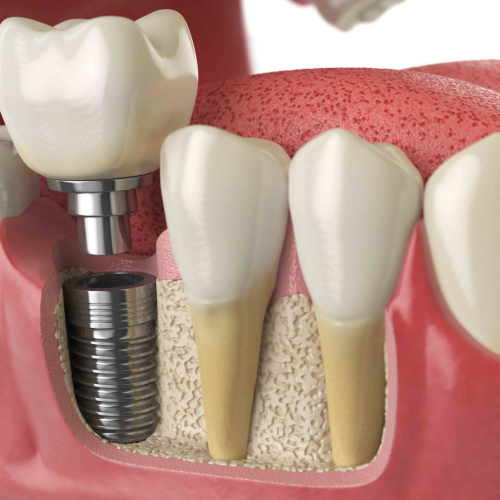

DENTAL IMPLANTS
The new generation of titanium dental implants is a true revolution in dentistry and in general in the restoration of lost teeth. This was made possible by the long-term research work of Professor Branemark in the 1960s and 1970s, who introduced the concept of "Osseointegration", i.e. the absolute connection of bone and implant under fully controlled placement conditions.
Since then many improvements have been made both in the surface of the implants, as well as in their shape and in their connection to the prosthetic work based on the implants.
QUESTIONS ABOUT DENTAL IMPLANTS
- What is a dental implant?
A dental implant is a titanium or other compatible material that is placed in the jawbone and replaces the root of a missing tooth. The missing tooth will be placed on it.
- Is there pain?
Usually the placement is done under local anesthesia and the patient does not feel any pain. It is also possible to perform the placement with a combination of local anesthesia and intoxication.
- How much time is needed;
This depends on the number of implants to be placed.
There is also the possibility of speeding up the placement process if a special surgical splint with the placement points is used. In this case, no incisions are made in the mucosa and sutures are avoided.
- Are implants safe?
The long-term use of osseointegrated titanium implants has proven to be a completely safe solution for the restoration of missing teeth. Success rates range from 96-99%.
ADVANTAGES OF DENTAL IMPLANTS VERSUS BRIDGES
When teeth are missing in adults, there is the old method of placing a bridge or the new and more functional one of implants
Simply put, an implant replaces the root of a missing tooth.
The implants are mainly made of titanium which has been proven to be well tolerated by the human body.
The doctor who places the implants must be qualified. It is possible to do it both with local anesthesia in the doctor's office and with "intoxication" in patients who have a phobia of oral surgery. In order to achieve the best result, two medical specialties work together: the maxillofacial surgeon and the prosthodontist.
Implantology is a part of Oral and Maxillofacial Surgery, a specialty of Dentistry and Medicine which includes a wide range of surgical operations & therapeutic applications, such as the simple or surgical extraction of a tooth, trauma from accidents, orthognathic surgery, oncological surgery, the restoration of various facial defects, the treatment of clefts, the treatment of jaw cysts, etc.
In the past, implants were not osseointegrated as they are today, they were not made of titanium but of other metals and also the prosthetic restorations were placed immediately after the implants were placed with meager and dubious results.
Osseointegrated implants were discovered by Professor P.J. Branemark in Sweden, who announced the ability of titanium to integrate biologically and functionally into jaw bone if a strictly aseptic surgical and prosthetic protocol is followed.
Professor P.J. Branemark placed the first titanium dental implant in a patient at the end of the 1970s. In Greece they have been used since 1985 and since then they have performed very well, solving many problems. Now many companies in different countries of the world manufacture titanium implants.
Today, implants are also placed in areas of the mouth where there is not a sufficient amount of bone.
In these cases, an autograft is used, i.e. bone taken from the patient himself or a heterograft.
After 3-4 months, the prosthetic restoration is done.
The implants are manufactured in various sizes and recently their surface has been roughened, as a result of which the adhesion surface is increased and the waiting times for the placement of the prosthetic restorations are shorter. There is also the possibility, in some cases, of a temporary prosthetic restoration on the same day and a permanent one after about 3 months, when the implant is fully osseointegrated.
The postoperative stage lasts 2-4 days, and the patient is covered with antibiotics and painkillers. At first there is a slight swelling, but this subsides after a few days.
The great advantage of implants compared to our well-known bridges is that there is no need to grind the adjacent teeth. The dentist's primary concern is not to affect healthy teeth in order to treat or restore another missing tooth. Also, chewing and speaking are not affected at all with implants. In case of total tooth loss, it is preferable to proceed with immobile prosthetic work with 5-8 implants or to construct dentures which are supported by 2-4 implants. The prosthetic works that are placed on the implants aesthetically, sometimes, look even better than the natural teeth.
One of the latest developments in the field of implants is the placement of both the implant and the prosthetic work in one day, through a 3D technology, where a computer receives a complete image of the mouth which the doctor sends to a specialized laboratory.
The doctor then receives instructions for the correct 100% placement of the implants and the immediate placement of the prosthetic work.
Of course, there are also cases where some diseases prevent the placement of implants, e.g. uncontrolled diabetes, patients taking bisphosphonate drugs, patients undergoing chemotherapy, etc.
In general, implants are suitable for all adults, even in old age, they have a very high success rate of more than 96% and medical research is constantly evolving, resulting in a continuous reduction in the time between implant and prosthetic restoration.
A beautiful and functional smile is an important factor for our self-confidence and health.







